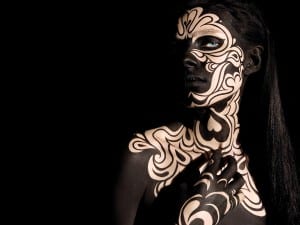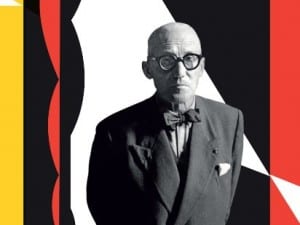Wayne McGregor, Olafur Eliasson and Jamie xx transform Jonathan Safran Foer’s book into an event that transcends individual disciplines.
It’s not unusual for dance to draw from literature: there are numerous famous ballets that take their inspiration from folk tales or stories, including The Nutcracker, Swan Lake, Giselle and perhaps most recently Matthew Bourne’s retelling of The Red Shoes. However, amongst these, Wayne McGregor’s Tree of Codes, first produced in collaboration with Olafur Eliasson and Jamie xx in 2015 for the Manchester International Festival, remains unique. This piece is exceptional because of the way that it relates to the novel that acts as its stimulus.
This unique event is inspired by Jonathan Safran Foer’s 2010 artwork and is a compelling exploration of the way that form can shape meaning. Unlike most of the ballets mentioned previously, McGregor’s piece draws less on the plot or characters and more on the nature of the remarkable publication. To create the story, the author took his favourite text, Bruno Schulz’s The Street of Crocodiles, and carefully selected which words to keep and which to cut, physically carving a new narrative out of the piece by making a die-cut of every page. It is a keen reminder of the physicality of language and of stories, something that is often forgotten or overlooked, in an age geared to digital forms and screens.
This then, is what the trio aim to investigate through the performance, which has its London premiere at Sadler’s Wells in spring 2017. Packed with notions of sculpture and layering, it seems tting that Eliasson and Jamie xx are the practitioners Wayne McGregor chose to partner with for the project: both demonstrate an a nity with these ideas through their previous works. Eliasson has included light and other elemental materials before in some of his more high-profile pieces, The New York City Waterfalls (2008) and The Weather Project at Tate Modern (2003). Though he is credited with the visual concept of Tree of Codes, the collaboration is conceived by the artists as being a whole: “We started out thinking of this as a pan-disciplinary opportunity and it turned out that it only really coheres as a gesamtkunstwerk.”
It’s a fascinating way of creating and the product is compelling. Figures from the Paris Opera Ballet and Company Wayne McGregor intertwine with a sophisticated visual design accompanied by the music of xx producer, James Thomas Smith. Danish-Icelandic artist Eliasson had met both Safran Foer and McGregor before and was familiar with the musical style that was to be adopted. He talks about how the author and he “discussed the haptic quality of the book” and how, contrary to what one might think about transforming words into theatre, it was relatively easy to imagine the transition: “When I read the novel for the rst time it was a physical type of immersion, because I arrived at the narrative from the discussion with Jonathan – how does the paper sound? What does it feel like? That meant that it was quite easy for me to translate that into dance.”
As Safran Foer does with his pages, so Eliasson layers his sets. He also plays with light and mirrors in a way that echoes the physical imagination of the publication: how things are seen and unseen at the hands of the author. He states: “The ideas for the on-stage environment were very much born out of the notion of what is physical. When do things have a physical dimension versus a digital or less dimensional space?” His use of re ection serves to include the audience, in the same way that the reader has to actively participate in the turning of pages. “You sometimes see yourself as part of the presented movements, re ected in the mirrors. The idea was to blur the boundaries between what’s in the room and what is being presented.” He talks about re-organising traditional hierarchy – “an organisation of who is active and who is passive” – so that where the stage is usually performative, the audience becomes “considered, or at least respected, as a co-producing element” in the piece.
This is echoed in McGregor’s choreography. Eliasson speaks of visiting the rehearsal room and experiencing the dancers as being an inherently physical act. Professor Lawrence M Parsons and his colleagues in the Department of Psychology at the University of Sheffield undertook studies in the early part of this century that suggest watching gestures unfold is very similar to actually moving – the same neural pathways are triggered. With this in mind, viewers are immersed into the gestural arena and take on some of the mental preoccupations with performance, as if they were on stage as well, much the same way that readers of a literal (as opposed to digital) novel have the same connection to that artwork, fully recognised as a necessary contingent.
Whilst the immersive environment creates duplicates of individuals, Jamie xx is “good at reflecting the spirit of a room musically” thanks to the “quality of his live DJing and his ability to listen to the audience in front of him.” The Mercury- Prize-winning artist has a history of intertwining the dialogues between practitioners and their voyeurs: shows with his band take on an atmosphere that is as much an installation as a gig, and they have collaborated with Manchester International Festival since 2013. There’s a “club-like” element to their sound, and this is something that provided inspiration: “I was excited about riffing off Jamie’s music: even though it is more experimental than conventional records, it still kind of has the context of club music. So some of the layouts, even though they are a lot more minimal and slow, they do lend to the underground feel of light and design.”
The visions of the three practitioners are so fully integrated that it is impossible to fully separate out who in uenced whom, and who constructed which aspect. Eliasson notes: “Maybe it’s more interesting to propose this as anti-disciplinary. There are no disciplines, they are co-producing each other. It’s interesting to see how we can collaborate without being egoistic: what is a true, altruistic collaboration?” His suggestion is that possibly Tree of Codes is it: literature, dance, music and visual art all combined to create the piece and “disconnected, they would be something completely different.” In the case of Safran Foer, we can see the truth in this – the book exists separately, and the visions of this unique collaborative triplet didn’t try to bring that narrative across or retell the story necessarily because, as the installation artist says: “It was not just about the narrative, but very much about the tangible nature of publications.”
In this pioneering performance, unlike other ballets that have taken texts as their inspiration, it’s not simply a case of rede ning or reinterpreting a story into a new form, it’s a case of actually reworking the form – delving into its counterparts and translating them into a new language. This is a show about how we see narratives and experience art. It’s a piece that is “not really about collaboration, but about uni cation.” It is a glorious celebration of the magic that can happen when we remove boundaries between disciplines.
Words Bryony Byrne
Tree of Codes. Sadler’s Wells, 4-11 March.





